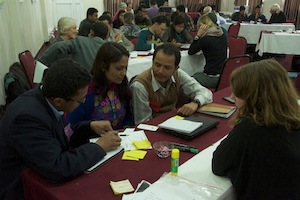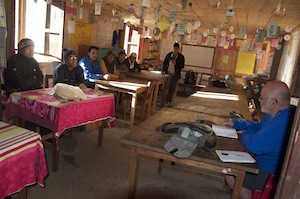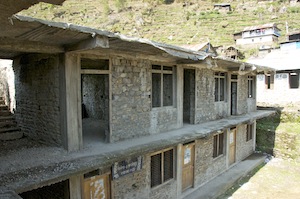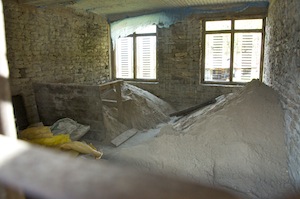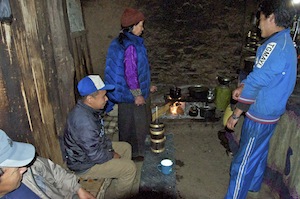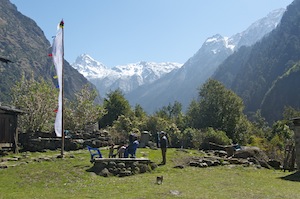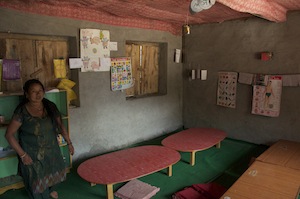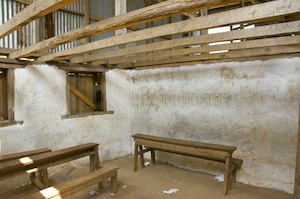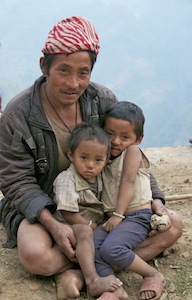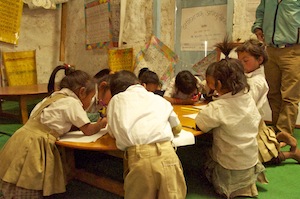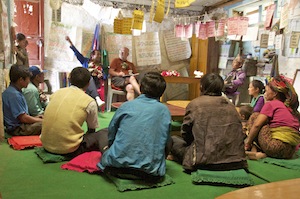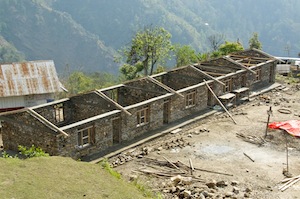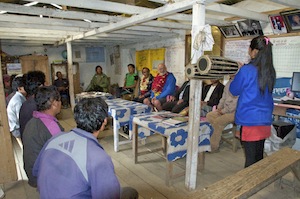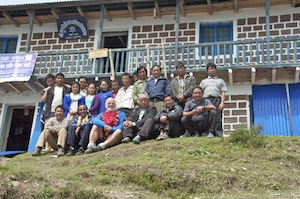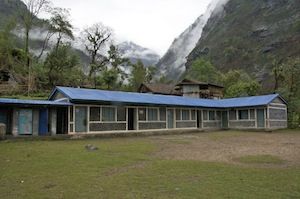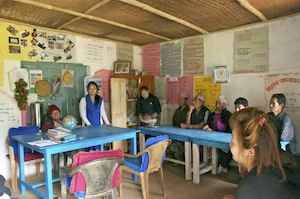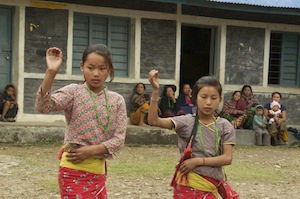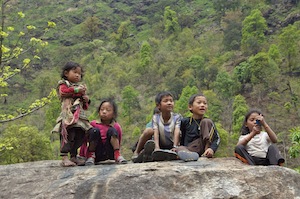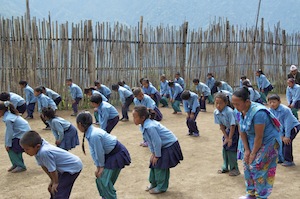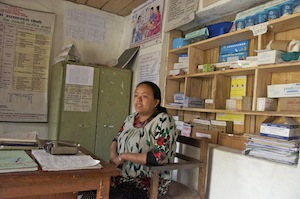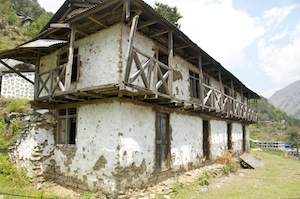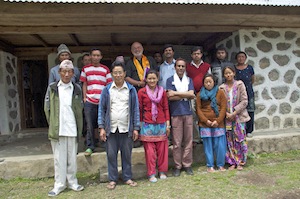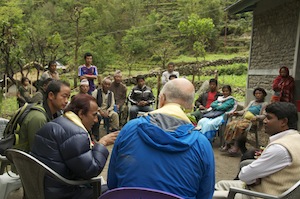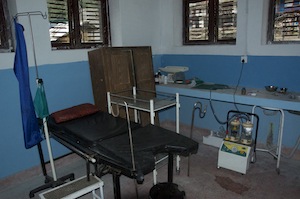Background and Objectives
The purpose of my visit to Nepal during April 2015 was to experience for myself the projects that the Himalayan Trust, in partnership with our NGO partners, REED Nepal, is involved with in the Kanchenjunga Region of north-eastern Nepal, known as the Taplejung District. Whilst the Taplejung District has 48 VDCs (Village Development Committees) we are, at this stage of the project, only working with five, although there is mounting pressure for us to extend the work into other VDCs. The five VDCs are Lelep. Tapethok, Yamfudin, Olangchung Gola and Ekhabu, all the furthest and most remote VDCs in the district. I was going to focus my attention on Lelep, Tapethok and Ekhabu, simply because time restraints would not allow me to visit all five.
The focus of our work is largely concerned with the training of teachers and the change to a more child centred learning style with greater use and variety of teaching materials. However, we are also keen to improve the environment of schools by providing new classrooms, toilets, clean water, protective fencing, teaching materials etc.
With this in mind, it was my intention to meet as many head teachers, staff, SMCs (School Management Committees), parents and Mothers’ Groups as I could, to witness for myself the strength of commitment to education within communities, to assess for myself the needs of each school, but, more importantly, listen to those involved as to what they considered to be their most pressing needs, and at the end of it draw up a priority list and cost assessment.
In addition to the educational focus, I was also looking at the health care provision, and through discussion with those providing a health service in very difficult conditions, and those communities that rely on them, how best we can help improve both the facilities and care provided.
So that the functions of my visit do not become incomprehensible, I will deal first with all of the educational issues and conclude with a section on health issues.
In Kathmandu
Before I left Kathmandu, I visited a workshop being run over several days for REED Nepal trainers and a group of volunteer trainers from New Zealand and Australia. This was aimed at bonding the two groups together and motivating them before a ten-day training session in both Lukla and Salleri. The workshop was being coordinated and led by Jim Strang, but with session contributions by both REED team members and volunteers. The session I witnessed included an investigation into a REED Appreciative Inquiry, the strengths and qualities of the individuals and the team that makes up REED, discussions following on from scenarios and roll play. It was interesting watching from the edge as there were some characters who, because of the confidence they possessed in both their use of language and their ability to perform, stood out.
Despite the fact that I only witnessed the inquiry into the Discovery element, it was sufficient to begin to understand REED. I quickly became aware that, among the Nepali teacher trainers, there was a pride in what they do and a commitment to making schools better places. I would have liked to have seen the outcomes of the other elements.
During my travels I was to be accompanied by Rajendra Pant, the district co-ordinator for Taplejung, Dorji Sherpa, who was there to look after me but who became my photographer, and a porter.
The journey to Taplejung involves a flight from Kathmandu to Bhadrapur, in the south-east corner of the country, close to the Indian border. Here we were only 90m above sea level and it is hot and steamy with temperatures well into the 30s and humidity in the high 90s, all a bit of a shock to the system. From Bhadrapur there is a long jeep journey, often taken over two days, but possible in one if you have a strong constitution and a driver willing to drive almost continually for nine hours. Our departure from Kathmandu was delayed by a couple of hours because of violent thunderstorms, so it was almost 3.00pm by the time we were ready to leave Bhadrapur. Fully expecting an overnight stop in Phidim about five hours drive away, I was pleasantly pleased when the driver suggested we go all the way to Taplejung if we did not mind arriving at midnight.
By the time we started the climb off the sticky plains the rain had begun to fall, and so it did for the entire journey, throughout which we had one brief stop for dal bhat, a welcome break from the endless hairpin bends. Arriving at midnight, as forecast, Taplejung was silent, even from dogs who do not like to venture out on wet nights. (In June the journey to Taplejung should be a lot more straightforward once the new airport at Suketar is completed. Then, subject to weather conditions, it should be possible to get direct flights from Kathmandu, which in effect could shave up to four days off any itinerary. However, it is very weather dependent.)
The following morning the sun shone and I was treated to a wonderful vista from my bedroom window, of snow-capped mountains, deep, lush valleys and a Taplejung going about its daily business.
I visited the headquarters of KCAMC (Kanchenjunga Conservation Area Management Committee) and the DEO (District Education Office) to announce my presence and seek their support in my trip of enquiry. While the KCAMC were very welcoming and supportive of my visit I was less impressed with the DEO who seemed distracted and disinterested. The overriding message from the DEO was the need to expand the work of the Himalayan Trust and REED into many more VDCs in the district.
The Fire of Taplejung
However, there was something that I felt important to visit and that was the site of the fire that took place just a few days before my arrival and had such a devastating effect on the community.
A week before my arrival in Taplejung, a gas cylinder in a hotel set alight in the early evening and the resulting fire quickly spread from the hotel to the tightly packed houses, shops and businesses around it. Most of the buildings were built of stone but had timber framed roofs with corrugated iron sheets over. All the internal walls were of wood, very dry wood, which quickly caught fire and helped it spread so quickly. There are no fire services in Taplejung, the nearest being in Ilam at least five hours away, so the people, having escaped from their burning properties could do little but watch as their homes and possessions disappeared in front of them. The metal pylons carrying cables along the street melted in the heat.
The only way the authorities could hope to contain the fire and prevent it spreading through the old market streets was to bulldoze some properties in an effort to create a firebreak. The combination of this action and the arrival of the fire tenders on Tuesday morning finally contained the fire, brought it under control and extinguished it.
The fire had destroyed forty-five houses, shops and businesses and displaced one hundred and thirty two families who had lost everything. The estimated cost of the damage is Rs 300 million (US$3 million)
By the time I arrived, a week later, smoke was still rising from the rubble. It was a scene of absolute desolation with people picking through the burnt remains for anything they could find that might have survived the conflagration. One woman simply stood in the remains of her house staring at the vacuum the fire had left, not just in the space around her but in her mind also.
There was an eerie silence about the scene, a reverence to those numbed by the disaster by those passing by, knowing that this could have happened anywhere in town, that it could so easily have happened to them.
I talked with some of the victims, and thankfully nobody was hurt, but they are feeling emotional pain, only deepened by the apparent abandonment of the government’s responsibility to its people. An emergency fund has been set up by the DAO (District Administration Office) but until funds become available there is little the authorities can do with their own limited capabilities. A token gesture has been made and some emergency funding has been handed out, people have been provided with sheltered accommodation or have found themselves with other family members. Local business people are rallying round, providing food and clothing to help ease the pain.
One of the most poignant images was of a family digging deep into the rubble to retrieve their rice stocks. Remarkably, some of the sacks were intact, protected from the fire by the collapsed stone walls, and the rice retrievable. I watched them picking out the burnt bits in the hope that their rice would still be edible.
Another was of a wooden shack that had once been a shoe shop, but now bulldozed out of the way to prevent the fire spreading. Thankfully, it worked but the sight of the shopkeeper trying to retrieve her shoes from the debris, her only source of income, was a distressing image, an image of desperation.
The school visits
Leaving Taplejung, we continued by the gradually lengthening road to Chiruwa, the present road head. It is a four-hour journey over a relatively short distance but on an unmade road, making progress slow and often uncomfortable.
On reaching Chiruwa we met our porter and started our trek to Tapethok, a small, but spread out settlement on the eastern slopes of the valley.
Having overnighted in a lodge we visited Saraswati LS School the following morning, a short walk over rice paddy fields and a short, but steep, climb up to the school. The school has 150 pupils ranging in age from 3 – 14 with five teachers and 8 classrooms. The children were playing in the playground prior to sitting their transitional exams determining their readiness for moving up to the next grade. Like children the world over, they were playing tag.
When Susan Band and Sue Leyden visited the school in the autumn of 2013, one of the main concerns was for the safety of the children in the playground. From its edge it drops very steeply and some children have, in the past, during the exuberance of play, fallen over the edge. Watching them, it is easy to see how this happens. As a result of their visit the Himalayan Trust UK provided the funds for a fence and while the posts are lying on the ground, no fence has been erected yet. I have been promised that it will be done in a month! Unfortunately, I won’t be here to witness it.
When most of the children had arrived an old oxygen cylinder was hit with a hammer and the children lined up in their forms. Music blared from a portable CD player and they mumbled the National Anthem. Then a couple of the children were chosen to lead ‘brain gym’ a series of orchestrated moves, again to loud music. This was approached much more enthusiastically by both pupils and staff. Some of the movements were very subtle, simply stroking their top lips or gently rubbing their shoulders. Others were much more expansive with exaggerated leg and arm movements. The purpose of these exercises is to focus the mind, a transitional period between the freedom of the playground to the self-discipline that is required in the classroom. The children have to focus their attention on those leading the exercise, to watch for changes and implement those changes in their movements. It is interesting to note that some are a lot more observant and reactive to the changes than others.
Brain gym complete the children formed a rectangle around the playground and marched round. I was instructed to take a seat at the end, whereupon a number of children presented me with garlands of flowers and the headmaster a khata scarf. It was all a bit embarrassing. The children then retreated to their classrooms in readiness for their exams but not before I visited each one and then had a meeting with the staff, the chairperson of the SMC (School Management Committee) and a parent. My question to each of them was, if there was one thing that the Himalayan Trust could do to improve the teaching, improve the learning or improve the school in any way, what would it be?
The responses were interesting and are as follows:
Headmaster – More successful teaching strategies
Chairperson – Increase the learning of the students
Maths teacher – Better behaviour from the students
New P teacher – Assess the problems of the students and adjust to a new situation. Interestingly, her husband is teaching in another school far away. Not ideal for their relationship but there are no local teachers to fill the place.
Limbu teacher – Maintain the Limbu culture
LS teacher – Would like to see more child centred teaching
None of these requests need significant funding other than a continuation of the training programme that will provide more teaching strategies, increase the learning capacity of the children and improve their behaviour through motivation and inspiration. I suspect the maths teacher is having most difficulty adjusting to new teaching methods and the child centred approach. Perhaps he needs to be singled out for additional support.
The new teacher’s situation, in tandem with the Limbu teacher’s comment suggests that there is a need for recruitment of good teachers locally. I hope, with time, that the improving quality of education might begin to produce good candidates for teacher training and thus fulfil that need.
The materialistic items requested, were:
- More science equipment, including a microscope
- Laptop, projector and printer, which will allow them greater variety of teaching material. Electricity is already installed in the school.
- Electronics equipment. A sensible suggestion as households are beginning to receive electricity from the micro-hydro schemes and there is going to be a greater need for the understanding of electricity, of its benefits and dangers.
However, I am inclined not to rush into providing this school with anything yet, on the basis that the Himalayan Trust provided funds for the fencing, which has yet to be erected. My inclination is to see if they keep to their word and erect it in the near future, in which case we might be able to consider their requests for teaching materials.
Leaving Tapethok, we headed up the valley to Lelep, on a stone-laid path, marking the route of the Great Himalayan Trail. It is a path worthy of any UK National Park but it does require you to concentrate on every foot placement, which eventually takes some of the pleasure out of it.
The lodge in Lelep is in an attractive setting on the edge of the village with a small courtyard framed with climbing plants draped off the building and a beautiful bougainvillea as a centrepiece. The village, too, is beautifully placed on a gently sloping shoulder of a much bigger hill. Houses surrounded by terraces and fields of potatoes and maize growing together add to the picture of tranquillity. Standing out, on the far side of the village, is Lelep School with its large grey block of a new building, not yet blending in with its surroundings.
Although I was staying in Lelep the focus of my attention for the time being was not Lelep School but two schools across the valley in Hellock. Dropping steeply to the Tamor River, we crossed by a suspension bridge and then climbed equally steeply to begin with to another area of terraced fields and attractive farmhouses with byres sheltering the occasional cow or large black pig with a piglet or two. Goats stood on the edges of the terraces and watched us as we climbed to our first school, Parvati LS School.
We arrived at the school in good time to watch the children playing Nepali Bulldog, very similar to British Bulldog but with better views. This tended to involve the larger boys and robust girls while the smaller children and many of the girls were marginalised to the edge of the playground, fenced off with bamboo and wire to prevent children from falling off the terrace. Nobody seemed to be on duty to exert some sort of control on the play, and it was unnecessarily violent at times with arms and legs thrashing out with venomous intent.
The ringing of the oxygen cylinder brought them under control and they lined up to sing the National Anthem, with a little more gusto than Saraswati School the previous day. This was followed by the same ‘brain gym’ routine. Afterwards the children went to classrooms while the staff and I went to the office/staffroom. Parvati School was damaged by the earthquake in 2011 and although the building I now found myself in had been patched up there were large sheets of polythene attached to the rafters protecting books, teaching equipment etc. from a leaking roof. The conversation I had with them threw up some interesting points. They are due to get electricity in the next two months and would like a computer and printer to make their preparation so much easier. Maybe they need a new roof first to ensure it does not get rain damaged!
The conversation with the head teacher, staff and chairman of the SMC came up with the following comments/requests:
Headmaster – Quality education is our aim. Improvements are needed to the buildings and the boundary.
Class teacher – School buildings, playground boundary fencing. Present facilities are very small. More training for teachers. Improve the learning achievements. Involve parents.
Chairperson – Unity among teachers and parents.
Class teacher – Team building among staff
Class teacher – More teaching materials and resources to provide variety of delivery
Limbu teacher – The main problem is the irregularity of attendance. Incentives needed to improve attendances at school.
Class teacher – Continue training. Need to educate the parents through involvement
Class teacher – Access to computers.
This struck me as a good school, doing some excellent work in some very difficult circumstances. The building is clearly too small for the numbers of children being catered for, despite the remark about poor attendance. The repair work following the earthquake merely did a patch-up job.
The comments about developing more unity between staff and parents, and for team building opportunities for staff suggests there are problems that are not necessarily visible to the occasional visitor. I think I would be inclined to ask Rajendra to look more deeply into these comments to see if there are issues or whether they are the result of working in difficult, cramped conditions.
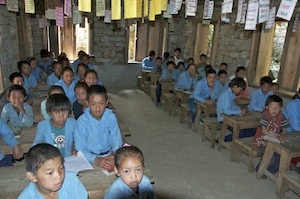
The children are only in mixed age groups for the purposes of the exam so that there is no opportunity for copying.
The comments about poor attendance were not peculiar to Parvati School and references were made on a number of occasions about scholarships or incentives for poor attenders. I see no point in penalising good attenders and rewarding poor ones for attending. That is counter-productive in my view. Surely, the way to improve attendance is for the school to be a vibrant place to be, where inspirational teachers and teaching encourage children to want to go to school. It is also a question of educating the parents and getting them involved and understanding the value of education.
My recommendation for Parvati LS School would be to explore the possibility of improving the teaching accommodation by significantly refurbishing the existing classrooms. Only when that is completed can we consider the other requests for teaching materials etc. We should also consider some more robust and permanent form of fencing around the playground.
Continuing up the Hellock valley skirting around the terraces and through small plantations of cardamoms, we reached the next school, Kanchenjunga Primary School. This lovely little school caters for about fifty children, all of who wanted to stay after their exam and wait for me. This is a poor school supplying the educational needs for some very poor families and it was noticeable that none of the children were wearing the usual blue uniforms that many schools seem to favour. Was this because families could not afford uniforms or were the rules much more relaxed here? As a result many of the children were scruffily dressed and there were many runny noses.
We were shown into the office, a ram shackled room with furniture not sitting square on the earthen floor. The head is the only teacher for the fifty or so children and there is a local Limbu woman with one eye that works as a teaching assistant. It must be an incredibly difficult environment to work in although the Himalayan Trust has recently provided a new block of two classrooms, replacing the old block damaged by the earthquake. This new block is perched precariously on an edge with only about a metre between the classroom doors and a precipitous drop of 10m or so. Fencing is a must. This school also does not have any toilets or running water, something else that needs rectifying fairly quickly.
The children were keen to have their photographs taken with us before they headed home so we perched on the perimeter wall and the children gathered round. Then they went home.
The conversation I had was largely with the head, with a little contribution from the assistant teacher. No SMC members or parents were there, perhaps an indication that education is less of a priority for this community. The head was very keen to thank the Himalayan Trust for the new building, particularly as the government provides nothing to this school.
At the moment there are five classes housed in two rooms with vertical streaming taking place so that children of different ages learn together.
The headmaster requesting the following:
- The provision of toilet facilities and a water supply for both drinking and washing.
- The new classrooms are in serious need of fencing to prevent children falling a considerable distance off the walkway.
- Mothers need to be educated about the importance of school so that they encourage their children to attend. Perhaps the creation of a mothers’ group where they can feel valued.
- There is a lot of poverty in the community. Many fathers work away from home and the mothers often require the children to do chores at home or in the fields. Perhaps the Himalayan Trust can provide a livelihood programme for the mothers.
- More stationery is needed.
There are some serious and important issues here, some, which are quite complex and I don’t think can be solved that easily. For me the priorities are:
- Construct a protective fence along the walkway of the new building so that children cannot fall off it to the terrace below. This would need to be keyed into the wall in order to give it.
- The construction of a toilet block and the installation of a water supply.
- The creation of a mothers’ group in order to generate a sense of belonging.
Having finished our discussions the head invited us to a nearby house for tea and noodle soup, both of which I would have preferred to pay for but was not allowed. I felt they could ill-afford such hospitality but they would have been offended if I had tried.
The following morning required a relatively early start. Although I was scheduled to visit Lelep School on my return from Ghunsa, the staff were concerned that the children would have finished their exams and many of the staff would have gone away for a few day’s break. As a result, I agreed to meet with them at 6.45am prior to me heading off up the Ghunsa valley.
At the allotted time we all gathered in the impressive staff workroom of Saraswati HSS, Lelep. It was a large room and is regularly used as a centre for teacher training where teachers from a number of schools gather for workshops. There was an array of teachers there and heads from other schools and although they all introduced themselves to me I was not always sure whether they were Lelep teachers or from elsewhere. As some schools had finished their exams Lelep was being used for training purposes, hence an assortment of teachers from outlying schools.
Before we sat down to have our discussion I visited the girls’ hostel and was impressed by how clean and tidy it was kept. There were still a few girls there completing their transitional exams. The toilet facilities for them, while being housed in a fairly old construction, were clean and had tapped water inside.
Interestingly, nobody wanted to show me the new building and there seemed to be a reluctance to talk about it. I remembered seeing photos from Susan’s and Sue’s visit in 2013 and progress has clearly been very slow. A roof is now on but little further progress has been made. The dispute between the head teacher and the chairperson of the SMC, who were both blocking progress has been resolved with both of them being replaced. The new headmaster and the new chairperson of the SMC are, according to Rajendra much more focused on getting the job finished. There was no evidence of recent activity on the site and I suspect that the funds have dried up.
Because there was a reluctance to talk about and show me the new building I felt it necessary to go back later, on my own and have a nose around. I was hugely disappointed with what I saw. I think the quality of construction is poor and there is still a lot of work that needs to be done to make the building useable. Two rooms, still unfinished, have furniture in and I suspect may be used for teaching in. Other rooms on the ground floor are full of sand, rubble or timbers and are far from useable. The rooms upstairs are merely shells and protective rails must be in place before any children are allowed near the building.
Even without my later close inspection I expressed my disappointment to the assembled teachers that this building was far from ready. I told them that I felt Lelep School was the flagship school of the region, the one that everybody went to for training. At the moment it is not fulfilling its promise and living up to the reputation it should have. A priority for the school must be, above all else, to finish this building and to have it occupied with children learning and benefiting from its existence. I could not believe the complacency of the staff towards this very frustrating situation. It would make their teaching so much better if it was finished.
Despite my moan about the building, the staff were very welcoming and their English, on the whole, was very good, which meant we could have a meaningful conversation without too much translation. They gave me an interesting array of requests, largely for inclusion in the new building but without mentioning it as such.
While the school has a girls’ hostel catering for twenty girls whose daily journey to school would be too far, they requested a similar boys’ hostel. The school has one, a derelict building on the other side of the village, in front of the health centre. In reality they want a hostel on the school campus. The government subsidises the provision of hostel places, making it an attraction to parents. (I later met a boy at Deurali who walks for two hours each morning to Lelep School, eats his lunch before school, which is not unusual, and then sets off home at the end of the day for another two hour walk home feeling hungry. A hostel would be ideal for him.)
The English teacher eloquently requested a laptop and projector. With electricity arriving at the school in the next few months this seemed a sensible idea. His reasoning for the request stems from the fact that the textbook they use has a section on computers, which means nothing if the students have not experienced one. Similarly, there is another section on ATMs. In view of the fact that they have not yet reached Phidim or Taplejung, I was tempted to suggest bypassing that section.
The resource manager for twenty four schools in the region praised the work of REED Nepal and requested an expansion into more VDCs.
In return, I explained to the assembled teachers that the Himalayan Trust will soon be expanding their work into better health care provision. I pointed out that opportunity would arise for them to promote health through their teaching but, just as importantly, we would be relying on them to suggest suitable candidates for health worker training.
The headmaster was not in attendance at the meeting so I only have requests from the teachers:
Teacher – Science lab equipment to go into the new lab in the new building.
Teacher – Visual aids – laptop and projector
Teacher – More teaching materials
Teacher – Make materials more accessible (Not sure what that means) Boys’ hostel. Safety fencing
Resource Manager – Spread the work of REED to other VDCs
My recommendation would be that we do not rush to satisfy these requests until such time as they have finished the existing building project. We can then review the situation again and help them make the most of the new facility. I will make my thoughts about expansion of our work known at the end of this section on education.
When I met the DEO at the end of my trip, one of my questions was to ask if he could put pressure on Lelep School to finish this building. He told me that Lelep School had received a warning letter about it and that as a result of the dispute between the head and the chairman of the SMC, the school account had been closed. Since the appointment of the new head and chairman of SMC the account has been re-opened so progress should soon be forthcoming.
Leaving Lelep, we dropped down to the Tamor River, crossed it by a bridge and entered the Ghunsa Valley. It is an incredibly narrow, forested valley with a thundering river roaring through it. All the foliage was dripping from last night’s heavy rain but it was extremely hot and humid despite the sun not yet reaching this deep into the valley. I found the narrowness and the vastness of the depth quite oppressive and the thundering river excluded all other sounds. There were plenty of birds in the trees and it would have been nice to be able to enjoy their song.
We continued up the valley, crossing the river on four occasions before reaching the long, 800m steep climb up to Amjilosa. I had had a bit of a wobble earlier in the walk where I realised I was getting dehydrated. Taking the opportunity to drink plenty of fluid I felt much better and I enjoyed the climb up to Amjilosa. There is only one lodge in Amjilosa and by the time we arrived there it was fully occupied by a group of Germans on the way down, so we had to continue for a further two hours to a small lodge at Thyanyani run by a family from Ghunsa on a seasonal basis. On first seeing the lodge I thought I might camp but it is so much easier if I don’t. Accepting the dark room with stone walls letting in the late afternoon light and draughts through little chinks I organised myself not to camp. In order to get to my room I had to duck my way through a dining room/lodge owners bedroom but the thrill was the kitchen, a dark room with a wood fire at one end, bench seats down one side and shelving and a work bench down the other. Everything on the shelves had its place and it was all neatly stored. As rain fell we huddled round the fire watching our dal bhat being cooked by a very capable young man. Dorji and my porter had a wooden tumbler of ‘tomba’ an alcoholic drink consisting of fermenting barley and hot water. An acquired taste. The dal bhat was the best yet, despite the most difficult and basic of facilities.
The following morning we climbed further up the valley to Gyabla, a small community of 55 people. We decided, because of my dehydration, that I would not continue to Ghunsa but Ghunsa would come to me.
The school in Gyabla is on the point of closing. It only has seven pupils, the children in the village preferring to go to Ghunsa to stay in the hostel, or Lelep.
Despite its imminent closure they requested the installation of running water. However, I recommend that we do nothing as it would be a wasted investment.
Phale School in the next village has already closed and requires no support from us.
Whilst in Gyabla I met a group of workers going up to Ghunsa to build a new hostel for the school. At the moment the school has 28 pupils but they are hoping that will rise to 55 with the provision of a new hostel and by taking more children from Phale, Gyabla and Amjilosa.
With the opening of Suketar Airport there will be a likely increase in trekkers to the area. The community in Ghunsa will have more trekking related work, particularly as it will be used more and more as an acclimatisation stop. The people there are also yak herders and produce many products from their animals from food to wools to clothing.
As requested the headmaster of Ghunsa School, LC, and teacher, Lok Nath, visited me in Gyabla. It was a strange meeting because all LC wanted to talk about was the creation of a rhododendron garden being created as the George Band Memorial Garden, with thirty-one species of rhododendron. He would like the trust to supply the funds for a fence. I pointed out that that was not what the trust was for. However, he persisted, saying that he was going to have a statue of George made and erected. There would be a charge for people to visit the garden, giving the school much needed income. LC also said he wanted to visit the land of George Band. As an afterthought he asked if we could provide uniforms for all the students.
Lok Nath struck me as being much more realistic and asked for financial incentives for teachers who would be required to take extra classes to occupy the growing population of pupils in the hostel. This would be for two years until the income from the memorial garden could take over.
During the conversation LC complained to Rajendra about an Australian, Andrew Stace from the Himalayan Development Foundation (Australia) and Jo Chaffer, an adviser to the British Council in Nepal for stirring up resentment in the community against him and other members of staff at the school. Hearing this, it seemed inappropriate that this should be happening, but when I met the couple at Amjilosa the next day and heard their side of the story, I began to realise that not everything was right at Ghunsa School. I have subsequently received a preliminary report from Andrew to be shared with trustees so that we can draw up our own conclusions and decide how we wish to respond to such information.
The report does not make for pleasant reading and suggests that there are serious problems at Ghunsa School. We spent the whole of the late afternoon and evening talking about the problems. I soon realized that there were genuine issues as both Andrew and Jo came across as very committed people with good knowledge of education and school management. On their return to Taplejung they were due to meet with the DEO and share their concerns with him.
I regret now not going to see it for myself but would recommend that we delay giving any funds to this school until such time as we have further information into its management, the performance of the teachers and we have a credible list of requests.
I knew that not every school would be perfect, and I had already seen some imperfection in those visited so far, but this depressed me as it seemed that there was very little right with Ghunsa School.
Moving back down the valley we returned to Lelep for one night before venturing up to remote villages high above the valley. After an initial steep climb out of the village, we picked up a path that contoured around the hills. During the Maoist insurgency all villagers were instructed to build paths between villages so that the Maoists could move easily and quickly from place to place. Whilst the insurgency was going on the villagers must have feared the consequences of this easier movement but today it make everybody’s journey a lot easier, including the children who have to use these paths to get to and from school. I was certainly enjoying walking on a good path that not only got me from A to B quite quickly but also gave me the opportunity to enjoy the views.
Eventually, after turning several corners we came to Sabriti Primary School, Madebung. We were there to meet the head teacher, a key teacher and the chairman of the PTA. They were waiting for us as we arrived. I knew immediately that I had come to a good school. A lot of effort had gone into making the classrooms bright and inspiring for the 72 children. There was also an early years room for ten children and this was bright and colourful and the only room with some carpet because they spend much of their time on the floor.
Having had a look around the school we retired to the office. The head is a youthful looking 43 year old with sixteen years as head behind him. He is totally committed to the job, unlike one or two we have met in recent days. So is the key teacher.
The conversation we had brought up the following issues:
- There is a need to focus on the regularity of attendance by the Some families are very poor and want their children working at home. Therefore, funds to form a Mothers’ Group.
- A community orientation programme to work with parents. Identify really poor families and provide scholarships to ensure better attendance.
- More focus on child centred learning and, thus, more resources.
- Continue with the teacher training programme.
- Concern over the payment to the ECD teacher who only receives Rs 3000 a month while a primary teacher receives Rs 18,000.
- Electricity will soon reach the school, within two or three months, so a computer would be useful.
In my experiences on this trip the most successful schools are those that actively involve the parents and community, so I would support the formation of a Mothers’ Group although I’m am not sure how it would need funding.
I am also at a loss to understand the concept of bribing parents and children to improve their attendance at school. I would much rather support a child who embraces school and whose attendance is good.
Increasingly, as I travel from school to school, I hear of the discrepancy in the standard of pay for ECD teachers against that given to primary and secondary teachers. This is a cause for concern. Those early years are so important, we must ensure that we get the best possible staff for the job and, therefore, work towards giving those teachers an acceptable salary.
Therefore, my recommendations for Sabriti Primary School are:
- Support, in whatever form it takes, in the creating of a Mothers’
- Continuing with the teacher training programme.
- The provision of more resources according to their specific needs, which might, with the introduction of electricity, include a
- An investigation into how the salary of the ECD teacher could be
Following our visit to the school we were invited to the key teacher’s house for tea and boiled eggs. We sat in her recently built kitchen in the yard and separate from the rest of the house while she cooked over a wood stove. There was a large open window looking out across the valley to the hills on the other side. What a view.
Contouring around the terraces, we left Madebung to visit Mahendra Lower Secondary School in Sangu. This was a complete opposite of the school we had just left behind us. Three years ago this school had 250 pupils but has rapidly declined to 50. Pupil attendance is poor but the blame for that lies with the headmaster and the staff. The head has a drink problem and neither he nor his staff turn up to teach. The children have been let down enormously and many have voted with their feet and attend more distant schools, or worse, do not attend school at all.
The school buildings are decaying rapidly and those that are in use still are dull and lifeless with nothing to stimulate the children. As far as REED is concerned it is a failing school and it has already had a letter from the DEO warning them to improve. Clearly the letter has had no effect. REED has withdrawn support until there are signs of improvement. Sadly it has not been forthcoming.
We were met by a deputation of parents who complained bitterly about the absentee head and staff. Neither REED nor the Himalayan Trust has any legal power with the DEO, the SMC need to protest strongly with the DEO in order to bring about changes. I offered to speak to the DEO on their behalf and suggested that if they wanted to make representation to the DEO, Rajendra would help them write a letter.
It was interesting watching the debate unfold. The men did all the talking and when we invited the women to have their say there was one man in particular who talked over them all the time. In the end we left them to continue and to turn their rhetoric into action.
I recommend that we do nothing for Mahendra LS School at this stage.
We now had a steep climb for an hour up through the six-foot deep terraces to Deurali where I was going to be camping on the school playground because of the lack of suitable accommodation. There was quite a gathering to meet us when we arrived and I was the subject of quite a bit of interest. As I sat there, enjoying the rest and the view, people would come, stand in front of me and watch my every movement, my facial expressions, everything. It was slightly unnerving.
When my tent was set up and I could disappear into it to get away from the stares, the flysheet would be unzipped and a head would appear in the doorway to have a look to see what I was doing. It was only when I pointed my camera at them that they disappeared.
I had dinner in the house of a local carpenter, the same carpenter that has been employed by REED to make all the furniture for the ECD units in the region. There was some delay in the serving of the meal as they had gone to great lengths to produce something special for their guest; they had sacrificed a chicken in my honour. While we waited I listened to rats foraging in the roof space above my head and realised that this might be reason why I was camping and not staying in somebody’s house.
When to meal came it was dal bhat with chicken, most of which was skin and bone and fairly inedible.
Although I had been looking forward to sleeping in a tent for a change it turned out to be the worst night’s sleep of the trip. The dogs were particularly active throughout the night and it soon became obvious I was on their patch. I was just beginning to doze off when one barked very loudly about two feet from my head. I nearly jumped out of my skin. On another occasion two dogs stood either side of my tent and barked at each other through it. So it went on throughout the night; I would just be dozing off when another spate of barking would erupt.
There was another reason why I found sleep difficult. The fatted calf, or skinny chicken, they had cooked especially for me was having an adverse effect and I was plagued with stomach cramps. By four o’clock the cocks were crowing, by five the Nepali dawn chorus of throat clearing and spitting and by six a group of children had gathered outside my tent. When I ventured to the toilet they followed me and waited outside the door, listening to my very vocal and unpleasant bodily function. I could see them through cracks in the door, pulling faces and sniggering. When I had finished they followed me back to my tent, only to follow me again to the toilet five minutes later.
It was a long time to wait for things to happen at the school; children were due to arrive at 10.00am as the teachers had prepared something special to coincide with my visit. However, the time was filled with people wanting to see me, to have a conversation with me in Nepali, which tended to be a one way conversation. One old man walking with a stick and clearly paralysed down one side got the message across that he was in pain and wanted pain killers. I gave him some and he went off happy. He returned later, at much effort to himself, to present me with a khata scarf.
Rajendra got into conversation with a boy, perhaps eleven years old, from the village who went to a different school, or did until his parents withdrew him because they could not afford the Rs100 (60p) transitional registration fee. Worrying about the impact this would have on the boy, Rajendra went to talk with his parents about the importance of education and persuaded them to allow their son’s education to continue. I don’t know whether Rajendra paid the Rs100 but I suspect he did.
Despite it being a Saturday and in the middle of the school holidays, at least two thirds of the 46 children at Deurali Primary School came to school for 10.00am. The only room available at the school is the ECD room so all the children, irrespective of their age work in this one room. There is a partially built new building with a further two classrooms but it needs finishing. The number of children attending this school is rising, largely due to the problems at Mahendra School 1500 feet below, so it is a priority to get the new building up and running.
Before they settled to their task, they stood proudly and sang the national anthem. Task motivated, the children were all well behaved and focused on the drawing task they had been given. Others worked on letter sounds. Once they had finished they stood in two lines, sang a song which ended with ‘bye-bye’ and filed out of the room to repatriate themselves with their footwear.
The formal part of the occasion now took place with a meeting of staff, SMC and parents. Having been inundated with garlands each person in the room was able to say what they felt the school needed to move forward. It came across during the meeting what a committed group of teachers and parents I was talking to.
The requests were:
- The new building urgently needs finishing so each grade can have its own classroom. The money from the DEO was not sufficient to complete the job. Extra funds needed.
- Water supply needed for drinking, toilets and for washing after using the toilets. (The pipes stick out of the roof of the toilets waiting to be connected to a tank but a tank needs to be in place and the initial supply needs to be found and piped to the school.)
- This community is very poor – support for uniforms. There are 4 very poor families – scholarships.
- Additional resources for ECD
The parents are committed to sending their children to school and they monitor their attendance. They came across as a very appreciative group of people.
For Deurali School I recommend:
- Funding to complete the new building, including the construction of a protective fence along the walkway outside the classrooms, where there is the typical long drop to the playground beneath.
- A priority is to find a supply of water to allow water to be piped into the toilets, and also to have an outside stand tap for washing and drinking.
- If funds are still available we can look at the issue of financing some support for poorer families with uniform etc. and the provision of additional resources for the ECD unit.
Feeling very positive about Deurali School, we left to traverse around the hillside to Sansabu. It was a delightful walk with lots of butterflies of all shapes and sizes. Crickets danced around my footfall, while lizards darted across the path. The usually elusive cicadas were in such evidence, not just by their monotonous loud noise but by their vivid yellow wings as they flew from twig to twig. Birds were also much in evidence, their song occasionally breaking through the noise of the cicadas but also by wonderful flashes of colour as they flew from tree to tree.
As we arrived at the lodge the first heavy raindrops began to fall. We were, by now, well used to the daily thunderstorm and we were, on every occasion, so far, lucky to have arrived at our destination before it occurred. However, despite reaching shelter before the rain came, it was necessary to get my waterproofs out in the lodge. My ceiling was also the roof of the lodge and a fine spray found its way through the corrugated iron and on to my sleeping bag and bed. The only solution was to cover everything with my waterproofs.
The following morning I visited Sundevi Secondary School, just behind the lodge where we were staying. It is quite a large school catering for 239 pupils. It is also a school where there is a lot of new development. A block of five new classrooms is under construction, being built by the Gurkha Welfare Trust. Unlike some of the new buildings we had seen, this seemed to be a much more sturdy construction and the craftsmanship of the builders seemed to be so much better. The site was well organised and, just by looking at it, you felt that thought and planning had gone into the project.
Having a tour of the existing classrooms they did not stand out as being particularly remarkable. More could have been done to make them stimulating to the children. My visit did not stop the builders from carrying on with their work and, on this particular morning, they were sorting out the sheets of bright blue corrugated iron roofing.
After my tour we gathered in a large room, which, as is often the case, doubled up as the school office and the staff room. Around the wall were photographs of school benefactors, who, collectively, must have made a benefit to the school. There was a large contingent of parents attending, confirming that there was a lot of interest in the community in their children’s education and for the welfare of the school. In their introductions, they all expressed their gratitude to the Himalayan Trust and for the support we have given them in the past. During the conversation I learned that the government does not provide any money for this school in terms of development, that the SMC and parents are very proactive in acquiring financial support from elsewhere, USAid and Japan as well as the Gurkha Welfare Trust and ourselves. They should be applauded for their achievements. It was also revealed that the government does not pay the salaries of the staff who teach grades 9 and 10. The school has grown since the government issued its quotas so those staff fall outside the government’s remit.
The conversation revealed the following important points:
Staff:
- We are committed to child centred teaching throughout.
- We wish to continue the teacher training programme and to acquire more resources.
- The secondary level of learning achieved is low because the government is not encouraging. Funding for Grade 9 & 10 teachers.
- Fencing around the school.
- Science lab plus equipment for teaching science.
The SMC and Parents:
- Fencing to protect the school environment from straying animals etc.
- They are impressed with the ECD room but would like more resources to go into it.
- There are 16 students studying in grades 9 & 10. More resources for that level of teaching.
- Scholarships for poorer children
- Monitoring attendance
This certainly is a committed community and some of the suggestions could quite easily be put in place if somebody was prepared to give it some time. I assume the scholarships are to help with uniform etc. but that was not made clear.
This would be a good school to help in that it is a forward thinking school and the education of the children is at the heart of everything they do. Therefore, I would recommend that we look at the possibility of:
- Improving resources, including those required for a new science lab once the building is finished, and also for the ECD room.
- Look at ways in which we, perhaps in partnership with the community, can fund the teachers not recognised by the government.
- Provide the funds for the protective fencing around the school.
Before we left the school we had a group photo with all the building work going on around us.
Formalities completed we gathered our things from the lodge and headed down the hill to Chiruwa, our base for three nights while we visit two more schools, a health clinic and a day enjoying celebrating Nepali New Year with the community.
At 6.00pm that evening another thunderstorm erupted with its usual heavy rain, thunder and lightning. The only difference with this storm as opposed to all the others we had experienced, was that it went on for fifteen hours, until 9.00am the next morning.
As we climbed out of Chiruwa up the short, steep slope to Phoktanglung the clouds hung in all the crevices of the hills creating atmospheric shapes as though the earth was steaming. Phoktanglung, which means shoulder in Nepali, is a shoulder of land that hangs above the main valley, and is the most beautiful village of all I have visited so far. The fields of potatoes and maize are beautifully kept with bamboo fencing keeping animals and people from walking on them. Dotted among the fields are attractive houses with corncobs hanging from the rafters and pots of colourful flowers on balconies. The paths through the village are clean, without litter, and you get a sense that the people here care about their environment and are keen to look after it.
Phoktanglung Primary School is another good example of a school built by the Gurkha Welfare Trust. The construction is solid, neat and tidy and, therefore, much easier to maintain. They have considered everything in their design, including building a boys’ urinal as well as the normal squat toilets. All the toilets have water piped to them and there is a tap outside to encourage children to wash their hands afterwards. The children have a flat playground to play on the there is a substantial bamboo fence protecting the school.
The insides of the classrooms were equally impressive with vibrant displays of stimulating material and children’s work.
There was a good gathering of staff, SMC members and parents suggesting that there is a lot of community interest in the success of the school. As we all gathered in the small office it was a little cramped. It became a little chaotic when it came to everyone, in turn, presenting me with garlands of brightly coloured flowers. However, once the presentations and introductions were made, everybody expressed their extreme gratitude to the Himalayan Trust. The meeting highlighted an alarming disparity in teachers’ pay in Nepal. It is incomprehensible to me that the government has a quota of schools for which it is prepared to pay the salaries of the staff. If you are not in the quota there is no money. This is the case at Phoktanglung. Not daunted by this the community has been pro-active in gathering together a fund from within itself, investing it so that teachers can draw a salary from the interest each month. The government will only pay the ECD teacher Rs3000 a month and the remaining teachers draw a similar amount from the fund. It is hardly surprising that some schools struggle with motivation. However, Phoktanglung despite the poor status it holds in the government’s eye, abounds with enthusiasm and determination from all involved. During the meeting it occurred to me that the Himalayan Trust UK should look at the possibility of developing a closer relationship with the Gurkha Welfare Trust where building projects are concerned. Their structures are much better than any others I have seen in schools.
The points that came up in discussion were:
- There are no government quotas for this school. If the Himalayan Trust could provide the salary for one teacher it would release more interest for the remaining teacher(s).
- The key teacher requested more training and more resources although she was not specific about the resources.
- The SMC Chairman requested that the present bamboo woven ceilings are replaced with sturdier plywood ceilings.
- New, robust fencing to replace the bamboo fencing, which has to be replaced every six months.
The salary situation was the one that I felt needed addressing as a matter of urgency. As it stands each household has donated Rs1000 into the fund. Those that can afford more have done so. They have also done some targeted fundraising and now have Rs350,000 in the account. The interest from that account provided Rs3000 per month to the two teachers. I am assuming that the ECD teacher is not included.
There was also mention of setting up a similar fund for the Mothers’ Group so that they could provide the children from poorer families, or those who had some distance to travel at each end of the day, with snacks etc. If we can secure proper earnings for the teachers there would be no need to set up another fund. It would already be there.
I promised that I would speak to the DEO about the salary situation.
My feeling is that this school deserves as much help as we can afford, so I would recommend the following:
- The Trust will guarantee the salary for at least one teacher to be reviewed each year in the hope that a quota will be allowed.
- We provide the funds for the replacement ceiling and the new fencing.
- We ask for specific details of resources needed.
- Having spoken to the DEO I have been assured that Phoktanglung is to be given one quota. This means that the two staff will receive a proper salary, more of the interest can go to the ECD teacher and some can be used by the Mothers’ Group.
It was a very satisfying meeting for there seemed to be a workable solution to all of their requests.
No sooner had this meeting finished, when the teachers from Sewalung Lower Secondary School came to see me. I literally just had time to discard my set of garlands to be festooned with yet more. The weather we had had over night prompted Sewalung to come and visit me to save me going up to them. The staff seemed to have a good command of English, except the head, who remained quiet most of the time and let his staff do the talking. Many of their comments were now common but these forward thinking staff came up with some interesting requests:
- Improve the playground area compound, including new fencing.
- Greater focus on early years with the development of an ECD unit.
- More maths and science resources – geometry boxes, beakers, conical beakers, round bottomed flasks, litmus and filter papers, spirit level.
- Multimedia projector
- Tape recorder
- Listening tapes. More stationery materials.
- New classrooms have been started but they are unfinished and the government money has run out.
I thought this was an interesting set of requests because it displayed the fact that the teachers had embraced the child centred approach to teaching and were looking at new ways to enhance their teaching and the children’s learning.
I think we should consider the following:
- Looking to finish the new building.
- Developing an ECD centre, possibly in one of the new rooms.
- Kitting out the new classrooms with furniture and resources as requested.
After the meeting two groups of girls from both of the schools entertained us with some cultural dancing on the playground.
The next day was Nepali New Year, the heralding in of 2073. The celebrations tend to be on New Years Day itself and not the evening before. The two villages of Chiruwa and Phoktanglung were joining together to celebrate with a feast on some recreational ground just outside Chiruwa. I had seen a sheep being reluctantly dragged through the village the evening before so I assumed, rightly in this case, that mutton was to be on the menu. It would make a welcome change from the daily dal bhat.
It turned out that I was the guest of honour, being the only white person in the area. The hosts of the celebration were the teachers I had met at Phoktanglung the day before and the medical officers from the clinic. I decided that as the doctors were doing the cooking the mutton would be okay to eat as I was sure they did not want a queue of people at their clinic door in the morning. In one corner of the ground large pots of food were cooking on wood fires and people began to gather. Typically, young children clambered on the rocks, older children played football, girls huddled together in conversation, men stood in deep conversation in another part of the field and the women nattered as they sat on the ground. Community gatherings are the same the world over.
Eventually the food was ready and I had to be served first. Rice, dal, vegetables and meat were ladled on to my plate. I use the term meet loosely. When Nepalis prepare meat they simply chop everything up, meat, bones and all of the internal organs. Nothing is left out, so when it comes to ladling the food on to a plate you have to take pot luck with what you get. I may have had one bit of meat, the rest being a mixture of bones and inedible tubes. I moved it around on my plate, ate the rice, dal and vegetables and pretended to enjoy the meat. When offered more I feigned being full and refused.
After the meal the music blared out over the field from two speakers with an extremely long cable that went I know not where. I was now expected to dance with every attractive young lady in the community while all the other groups continued their clambering, conversations or playing football. It was all a bit embarrassing, particularly as some of the men had now consumed quite a lot of whisky and had lost all inhibitions as they tried to join in. I was only offered fruit juice, which does nothing to loosen the inhibitions. It was time to leave.
After our day off we left Chiruwa and climbed steeply up the hill on the other side of the valley. Despite leaving early in the morning it was incredibly hot work. In places the path was quite exposed with severe drops to the valley below. But it was also extremely beautiful with butterflies and birds accompanying us all the way. Near the top of the ridge the path began to contour around the hills, climbing less steeply but still very exposed in places.
We were heading towards the village of Khani, the home village for our porter. He knew these paths extremely well and there was definitely a skip in his step despite the fact that he was carrying my kitbag, a tent and his own kit. He kept having to play catch up as everybody we met on the trail knew him and wanted to chat.
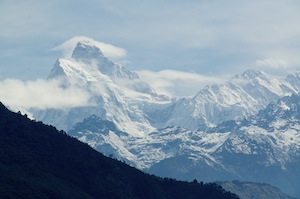
Jannu. In Limbu it is known as Phoktanglung, which translates as shoulder. It is the shoulder of Kanchenjunga
Eventually we reached a temporary high point where we stopped for a rest. Looking back I saw my first, unobstructed view of the mountains I had had all trip. Jannu looked stunning.
We continued to contour around the hillside following the line of the terraces before climbing steeply again to the school. Before we reached it we came across the ruins of the old school, abandoned because of its proximity to a landslide. It had been a two and a half hour climb with an ascent of about 800m. By the time I reached Rani Lower Secondary School I was pleased to see the children playing on the playground as it gave me some time to recover before getting involved.
Of the schools given funding for perimeter fencing, it is the only one to have completed the task. The very active parents’ group created sturdy white concrete posts joined, sadly, with barbed wire, but it will be effective in keeping out straying livestock and unwanted people, and ensures that the school environment stays safe and clean. Box hedges have been planted, a small vegetable patch looked after by the children, flower beds and litter baskets adds to the assurance that this is a well looked after school. It is a place everybody can be proud of. The flat playground is, fortunately, not subjected to the barbed wire boundary but has the more aesthetically pleasing bamboo, which, in common with other schools, needs replacing every six months, and requires something more permanent.
School was about to start and the clanging of a metal disc brought all the children into lines on the playground. Having done the arms length shuffle, music blared from a small tape recorder and the children sang the National Anthem. Four older children were selected to stand out in front of the school and lead the, now familiar, brain gym routine. What a setting, perched on a terrace, protected by a bamboo fence, but dropping steeply to the valley below and with stunning views of Jannu and adjoining peaks, now with clouds bubbling around them. Once the brain gym was finished the children rushed off with controlled enthusiasm to their classrooms from where soon chorused class songs to continue the enthusiasm.
Once they were settled I toured each classroom to observe a variety of lessons. An English class was singing an action song about being healthy, cleaning teeth, washing and eating well. The children were enjoying themselves. Next door an enthusiastic teacher was teaching maths with a vibrancy and a smile I have rarely seen in Nepal. He was sticking pieces of paper with numbers written on them onto their foreheads and they had to follow his instructions and pair up accordingly. Everybody was smiling and enjoying. It was the same throughout the school, right down to the early learning class where the children were playing and, unbeknown to them, learning.
Leaving the children unsupervised but well motivated and disciplined, the staff gathered in the office for the formal part of my visit. Having festooned me with flowers they talked freely about what they would like and need. In common with other schools there is an extension in progress, which needs further funds for it to reach completion. At the moment the school is for Grades 1 – 5 but has been given the go ahead by the government to include grades 6 and 7. This means there will be specific science needs, which will probably have to take priority over some of the other requests.
There were several representatives of the SMC in attendance and a very vocal group of mothers who are very actively involved with the school. They would like a fund to manage so that they can provide snacks for the most needy children.
Their specific requests were:
- Funding to complete the new building, which consists of 4 classrooms on two levels.
- A computer/science lab to be housed in one of the new classrooms.
- Science equipment.
- A laptop, projector and printer (They already have electricity).
- Globes and other visually stimulating material.
- Big Books – large books so that the children can focus on that and the teacher. (We used them in the UK in the latter years of my career)
- The ECD teacher requested more toys and teaching materials.
- This is a model school for parental involvement – some funding for the Mothers’ Group so they can manage the provision of snacks for those children who travel far to and from school and those most needy.
- Scholarships for very poor children. (16)
This, I felt was a wide-ranging and comprehensive list of requests. My priorities would be:
- To complete the construction of the four new classrooms and fit them out accordingly so that one is a bespoke science lab/computer room.
Of course, I would like to fulfil all of their wishes but we would need to see what funds were available to take it any further than my initial recommendation.
Before we could leave we had a more detailed tour of the school environment, the impressively kept toilets and washing facility in particular, and they provided us with noodle soup for lunch.
If I thought the climb up to the school was arduous the 1000m descent to Siwan was worse and harder. For the most part it was steep with awkward steps down on steps made for small Nepali feet in flip-flops and not clumpy size 10½ boots. The jarring effect on ankles and knees was painful. In places we came across deliberately lit fires burning their way through the undergrowth destroying anything small but leaving the trees largely unscathed. I can only imagine that this was done to encourage new grass growth for cattle to graze on. There seemed to be no other plausible reason.
It was with some relief, after nearly three hours of jarring concentration, that we reached the valley floor and walked along the side of the river. That relief turned to disappointment as I walked through the street that is Siwan. It is a typical Nepali road-head settlement made up of shoddily built shacks all selling the same products. The street is filthy and the people sit idly at the side of the road with nothing to do. Arriving at the only lodge in the village did not improve my impression of the place but took it down several more notches. It was a corrugated iron shack run by two surly young men who cared little about what they did and had no passion for making people both welcome and comfortable. I was hot, I was thirsty and I was tired and I would have appreciated a little more comfort than this place was going to provide. The ceilings in it were so low that I had to walk with a pronounced stoop to protect my head. The doorway into my room was only 5 feet 4 inches high and my head came into contact with the lintel so often! The walls in my room were papered with sheets of newspaper, the mattress was filthy and, I feared, flee ridden. I was not going to get my sleeping bag out and risk getting it infested.
Trying my best to relax, my eyes began to feel sore and the air was smoky. Turning on my head torch smoke drifted across its beam. There was no way I could stay in there. Ducking my way downstairs I found the source of the smoke, an earth fire at one end of the room that did not have a chimney but filled the whole building with smoke.
Dinner that night was a tasteless and unappetising dal bhat cooked by the surly and incapable pair. By the time I went up to my room, hitting the lintel yet again, the fire below was out and the air clear. Sleep came remarkably easily despite the circumstances but I was woken at 12.40 by a telephone conversation in a room nearby. It was one of the surly pair talking to a girl on the other end of the line, her voice clearly audible. This conversation continued for an hour. Thinking that was the end of it, he then started to work through his contacts list and ring them all with varying degrees of success, until about 3.00am!
At first light I got up, packed my bags and vacated my room as quickly as possible. I could not wait to get away. First I had to endure breakfast, the only choice being hard-boiled eggs, all of which were bad and inedible. It was with some reluctance that I paid the bill but equally a huge relief when the land cruiser came to pick us up.
In Taplejung, once showered and clean, Rajendra and I visited the DEO and had a very open, honest and productive meeting with him and some of his senior staff. When I first met him I did not take to him easily as he seemed distracted and disinterested. This time, he unplugged his phone, and focused on my questions and points rather than fobbing me off with platitudes, which he could have easily done.
Having stressed the positives of my visit I then embarked upon a number of questions:
Q1. Should the DEO put pressure on Lelep School to finish the new building?
A1. Most of his answer has already been covered but he assured me that the problems have been resolved, the account re-opened and that with new personnel involved the building should be completed soon.
Q2. Why are there so many schools with unfinished new builds and why can the government not provide the funds for completion?
A2. The national standard amount the government provides for new builds in schools is Rs750,000. This includes transport costs of Rs70 per kg. If the school is close to the road head or easily accessible this tends not to be a problem but if it takes several days to get the materials to a remote school, a lot of the money goes on transport costs, which then does not leave enough to complete the construction. It is then up to each school/community to find the extra funds needed. The government will not increase the amount they give despite the varying circumstances of each school.
Q3. Phoktanglung School does not come within the government quotas for teachers. While the teachers do an excellent job they rely on the local community for a salary much less than those who fall within the quota. With the closure of Phale, Gyabla and Yangma imminent, if it has not already happened, can their quotas be given to Phoktunglang School so that their staff can receive an appropriate wage?
A3. One quota is being provided to Phoktanglung School this year.
Q4. Why do ECD teachers receive such poor pay when the government wants to promote early learning?
A4. The government policy is that the DEO pays 50% of the salary (Rs3000) and local government pays the other 50%. However, local government has reneged on the agreement .
Q5. Mahendra LS School has serious problems with non-attendance of staff, including the head. What can the DEO do about it? The parents are very unhappy.
A5.The SMC need to submit a document seeking action from the DEO. Without it he can do nothing. He is aware of the problem. REED to follow-up. Once he has received a formal complaint the DEO has several courses of action:
- Reduce the salary of the head and staff until such time as they improve.
- Appoint a new teacher with a good record to apply pressure on the head teacher to improve.
Q6. Similarly, the head of Ghunsa School is absent for 8 months of the year and the school is in serious financial difficulty. What can you do about that situation?
A6. The DEO is aware and has spoken to LC twice on the matter. Pressure is being applied. LC is not at liberty to discard his responsibility for the hostel and the Women’s Group is not allowed to take responsibility for the care of the children in the hostel. The DEO will be keeping a close eye on the situation, particularly as there are new buildings for hostel accommodation being built at the moment.
This is just a précis of the conversations that took place in the room and the last two questions did generate a lot of debate among the DEO staff. I felt it was a worthwhile exercise. One thing that did come out of the conversation was the DEOs desire for the Himalayan Trust UK/REED teacher training project to be spread into more VDCs, and into more populous ones so that they could see the benefits reaching more teachers and children than in the more remote regions.
To conclude my visit, I went to the DAO (District Administration Office) to discuss a proposed donation to the Taplejung Fire Emergency Fund. I met with the acting chairman and a colleague who explained the details surrounding the emergency fund for those affected by the fire. I made it clear I was looking for clarity and transparency and that I wanted assurances that every penny the Himalayan Trust donated would reach its intended target, namely those most in need and not into bureaucratic back pockets. I felt confident that with REED keeping a watchful eye over it, we stood as good a chance of any for our money to achieve its maximum potential.
Recommendations for expanding the work of the Himalayan trust UK and REED into more VDCs
First of all, it is worth pointing out that the project is a resounding success in the eyes of the teachers, the SMCs, the parents and communities, and the DEO. There is a huge desire for the training to be implemented across all 48 VDCs that fall under the jurisdiction of Taplejung. To consider this would be impractical and would require a huge growth in the personnel of REED Nepal and huge financial investment from the Himalayan Trust UK.
I think it would be dangerous for REED Nepal to grow so vast. It would become unmanageable and as a result begin to lose quality in favour of quantity.
The Himalayan Trust UK does not have limitless funds and we would not be able to fund the project adequately, again reducing the quality of our achievements.
I think the way forward is to approach it slowly, to complete the task we are doing in the existing VDCs, specifically focusing on developing the present stock of key teachers and increasing them from the present 12 to 20 – 24. Then, when we are ready to move into a neighbouring VDC we make use of the key teachers as a source of inspiration and leadership, all under the guidance of REED. Those key teachers will continue to work at supporting the staff in their own schools, while REED also monitor progress in the existing VDCs, but will then take their skills into schools in a neighbouring VDC to work with REED to train all staff, to highlight suitable candidates within those schools to become key teachers in their own right.
This will make use of the existing talent in the schools and be cost effective for both REED and the Himalayan Trust UK. The key teachers would need to be given some remuneration for their extra work, and REED’s expenses would be increased, but the vast majority of the Himalayan Trust funds could be focused on the need to improve the facilities and resources of a new batch of schools.
Health
During the course of my visit I looked into what health care is provided now, what the health workers felt was needed and how the Himalayan Trust can help.
Before I left Kathmandu for my travels, I met with Dr Jangmoo and Lakpa, who are going to be our partners in Nepal, driving the project and programme forward, once it gets under way. I found them to be intelligent, personable, very competent in their use of English and thoroughly good company.
I agreed to meet with Dr Jangmoo on my return to Kathmandu, to discuss my findings and to relate to her what my impressions were. Lakpa would be away at the time.
Debbie had given me a questionnaire to use, which gave good guidance to me as to how to direct any conversations I had with those I met. Whilst this form was very useful, I tended to forget to use it when meeting teachers etc.
My first health port of call was Taplejung Hospital and the District Health Officer, Dr Krishna Subedi. Whilst he appeared very supportive to our desire to become involved in health care in the region, it soon became apparent that he may not soon be our point of contact. He originates from the Terai, via Kathmandu. and, by his own admission, cannot wait to go back to Kathmandu. He has no interest in public health, being a clinician and is waiting for the day when a job opportunity comes up in Kathmandu. However, he took the questionnaire and said he would give lengthier answers and email them, and include a report on the main health issues of the region. When I asked him what happened in the remote areas if you had a patient with appendicitis or a compound fracture, he nonchalantly replied that they die. It is hard to believe that such simple things could be so catastrophic.
He then took me to visit the hospital and I could think of nothing positive to say about it. It was dirty, spartan, lacking in equipment and generally unpleasant.
Intending not to need the facilities of Taplejung Hospital I went off into the hills.
The first health post I came to was at the end of my first day at Tapethok. When I visited I talked to the Assistant Health Worker about her work, the most common things she had to deal with and how she managed to treat them. A large chart on the wall listed symptoms on one side and drugs to treat those symptoms on the other. All the time we talked she breast-fed her toddler and I wondered how she would cope balancing the needs of a toddler and the needs of a patient. The clinic is open six days a week from 10.00am – 5.00pm
During our conversation she revealed that the main issues were respiratory, diarrhoea, tonsillitis, gastritis and urinary track infection. When I asked about vaccines, she told me that they are brought to her on the 10th of every month and the vaccinations take place on the 11th – 13th of every month.
When I asked what she would most like to improve the work of the clinic she gave me the following suggestions:
- More room
- Testing equipment i.e a lab technician to do blood and urine tests, to save having to send samples to Taplejung.
- A third health worker. There are two at the moment who share and rotate the responsibility.
- 24 hour electricity
- A water supply to the building.
- Additional incentives to health workers
I also met the chairperson of the village health committee who had the following requests:
- A kitchen
- A waiting room
- A Fridge for vaccines (which will need either 24 hour electricity or a battery generator)
- Two more trained health workers
- Lab technician and testing equipment.
Unlike the hospital at Taplejung, this health clinic was clean and well organised. Some of the equipment was a bit basic and crude but it served its purpose for the local community.
While in Gyabla I spoke to the lady running the lodge where I was staying. She was very helpful in providing information as a resident of a village without any health care.
She wanted:
- A new health post in Gyable (with a population of 55 does it warrant the amount of investment that would require?)
- Health workers in the community (when I asked her if she would like to train, her eyes lit up at the thought)
- Medicine – access for childbirth
- Helicopter evacuation. It cost 4 lakh, otherwise likelihood of dying
- Dental care
- Train local people to work in the local communities
When I asked her how much she relied on homeopathic treatments she said that she would always try them first before walking to the health post at Lelep.
The next health post I visited was at Lelep.
Setting out from my lodge I climbed steeply up a small ridge up to the health post. My first impression was that the clinic is in entirely the wrong place, at the top of the village and apparently not easily accessible, although I am sure there is another less arduous route. I felt it was not ideal if you were ill or injured.
On the way we passed the ruined boys’ hostel, which Lelep School wants to renovate. It would be better to start again.
At the clinic the Community Medical Officer and two Auxiliary Nursing Midwives met me. The Chief Community Medical Officer, whom I met briefly the day before, was treating a patient over in the Hellock Valley.
We met in the consulting room. There is also a treatment room and a storeroom. Introductions done we discussed the points on Debbie’s questionnaire and as we did so a number of people joined us, a pregnant girl and her friend and a number of elderly gentlemen who happened to be members of the Village Health Committee, gathering to discuss the purchase of land and the building of a new health clinic in a much more accessible part of the village.
Both the Chief Community Medical Officer and his assistant and two of the nurses are from the Terai while three female staff are local. The CCMO has been in residence for 7 years and is very happy with this position and living here, but his assistant wants to go back to the Terai where he has a wife and small child.
Similarly, the nurses from the Terai also want to go home. There is no accommodation associated with the health clinic so they have to use part of their salary paying a lodge owner a rent. This highlighted the need to recruit locally for staff and to also provide some form of accommodation for those that are not local.
I was intrigued by the desire to move and build a new clinic elsewhere. There seemed to be a simple solution. The school wants a new boys’ hostel but the one they have is derelict and in the wrong place. Why don’t the school let the clinic have the derelict building and the site, which is immediately in front of the present clinic, so that they can build an extension to include staff accommodation. They would need to build better pathways to make it more accessible. The school could then build a boys’ hostel on the school campus by converting and refurbishing some of their old classrooms, once the new building is fully operational.
Having relayed my ideas to the Village Health Committee I asked them to let me know what they thought of it and what they decided.
Later in the day they showed me the piece of land they wanted to buy, just below my lodge. It belongs to a villager who now lives in Kathmandu. They claim to need 5 ropani (1 ropani = 508.72sqm) The cost of 1 ropani is Rs2,000,000, meaning a total outlay of Rs10,000,000, or approximately £69,000. On top of that they would have to build the clinic, making the total cost prohibitively high. The reason why the clinic is where it is now is probably because the land on the edge of the village is that much cheaper. The other attraction to them moving the clinic is that the road is going to reach Lelep in three years and this piece of land will be adjacent to the road.
I still think my suggestion is both more practical and cost effective and I could see us being more willing to help the school with the building of the boys’ hostel if they were both accommodating to the idea and determined to finish the existing building project.
Whatever the outcome, we have to look at what they have got now and what would help them now, in their present situation.
There are seven staff in total:
- 1 Doctor or Chief Community Medical Officer
- 1 assistant Community Medical Officer
- 3 Auxiliary Nursing Midwives
- 1 Village Health Worker
- 1 Office Assistant
Their collective requests included:
- Instruments for the birthing centre
- X-ray equipment
- Accommodation for staff
- Once the government decides how many rooms they will provide, in terms of new build, they could increase capacity.
- Build a new clinic
My fear is that the community are sold on the idea of buying land and building a new clinic based on the future of the road, that they may well be blind to any other suggestion, however practical or economically sensible it is.
The third clinic I visited was at Phoktanglung. The clinic had been built by the Gurkha Welfare Trust and had that sturdy, well-built look about it. I visited it after visiting Phoktanglung School and meeting the staff from Sewalung. Everybody followed me so by the time we reached the clinic there was a good gathering of people, representative of those served by the clinic. In effect the clinic serves all the villages in this particular valley, Chiruwa, below and the communities leading up to Khani. It is in a beautiful position, looks well cared for and the Community Medical Officer seems to be an enthusiast. I was staying in Chiruwa for three nights and I regularly saw him in the village talking to people, visiting houses and he was one of the organisers of the Nepali New Year celebrations.
The clinic has:
- 2 Community Medical Officers
- 1 Health Worker
- 1 Office Assistant
There requests included:
- A nebuliser and instruments to control pneumonia
- Sterilising equipment – gas stove to boil water
- Fridge to keep vaccines
- Lab assistant and lab testing equipment
- An Auxiliary Nursing Midwife
- A Birthing Centre
- Involve local people to maintain the health post ids open all the time.
On the whole these seemed like fairly simple requests, which would make a huge difference to the efficiency of their work. The only problem would be how to incorporate a birthing centre or is there the capacity to build/convert one?
My final visit to a health post was to the new government post in Siwan. This is, by far the best looking building in Siwan, at least from the outside. As a government run clinic it is supposed to have all seven members of staff on duty from 10.00am to 5.00pm. When I visited at 4.00pm the place was deserted. Eventually, somebody went to find a member of staff, who strolled over to see us from somewhere in the village.
She allowed us access to the rooms on the ground floor, all those on the first floor being staff accommodation.
The rooms were uninspiring, the floor was dirty, she had a lazy, don’t care attitude about her. There was absolutely no enthusiasm in her voice for the work she was doing and, clearly, no pride in the fact that she had a new facility. Had she got pride she might have kept it cleaner.
This facility disappointed me and I was much more impressed with those facilities in Tapethok, Lelep and Phoktunlang.
I think there are probably enough clinics in the valleys. There is another at Ghunsa and one at Olangchun Gola. Perhaps we need to develop these further to give them greater scope, to increase the staffing levels with local staff. I would suggest that we could train village health workers for those villages that do not have a clinic so that each village has a first port of call in an emergency.
It was an inspiring visit, which I thoroughly enjoyed. I am hugely grateful to Rajendra for guiding me through the area, introducing me to some very hard working teachers, parents and medical practitioners in the area, but also for not being afraid to show me schools and communities that are not always functioning as we would like. I returned to Kathmandu with a lot of ideas floating around in my head and knew that I had to make decisions that would affect the the work of the schools I had visited. I was determined that as many schools as possible should have some reward for the hard work they do and that those schools that will inevitably miss out this time are encouraged with the knowledge that funding will be available for them in the future.
I also returned to Kathmandu to meet up with Stephen and his team who had just successfully climbed Mera Peak. Well done!!
Four days after I left Kathmandu the first devastating earthquake occurred on the 25th April. The area I had spent such a happy and productive time in was largely unaffected by it. Releif was short lived, when a second earthquake struck much closer to the Taplejung District on the 12th May, damaging some of the schools I had visited. Without jeopardising the dynamic fund available for the improvement of schools there is now a priority to repair, rebuild, or whatever is necessary, the schools and clinics affected. The slogan is “Build Back Better” and we will.

